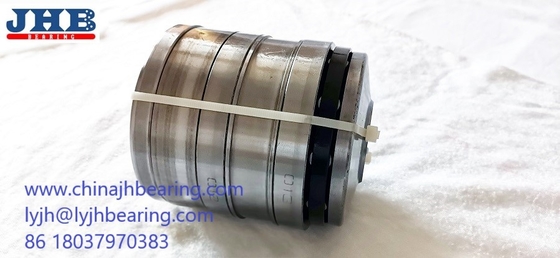 |
|
|
|
2 row Tandem roller bearing T2AR1242 12x42x41.5mm in stock for plastic extruder gearbox
Product Details:
Payment & Shipping Terms:
|
| Precision Rating: | P4 P5 P6 | Cage Material: | Brass |
|---|---|---|---|
| Number Of Row: | 2 Row | Outer Dia: | 42mm |
| Inner Dia: | 12mm | Shaft Dia: | 41.5mm |
2 row Tandem roller bearing T2AR1242 12x42x41.5mm in stock for extruder gearbox
Tandem bearings T2AR1242 consist of several axial cylindrical roller bearings arranged in line, A system of rings and washers matched to each other ensures that all stages of the tandem bearing are subjected to uniform load at all times irrespective of the ratio C/F. The rings and washers are made from hardened steel. Tandem bearings are predominantly fitted with standard axial cylindrical roller and bearing assemblies. The thrust cylindrical roller bearing T2AR1242 with size 12x42x41.5mm, the inner diameter:12 mm, the outer diameter:42mm, the total height:41.5mm
![]()
| Tandem bearing old code | Basic size unit(mm) |
Basic load rating Unit (KN) |
material | |||
| Inner dia | Outer dia | Height | Cr | Cor | ||
| T2AR1242 | 12 | 42 | 41.5 | 70 | 157 | Steel chrome |
JinHang Precision bearing offer Tandem thrust cylindrical roller F‐53043 bearings have the characteristics of small radial cross-sectional size, compact structure, large axial load capacity, uniform load of each row of rollers, wear resistance, low vibration noise and long life. They are parallel twin screw extruders. Ideal screw spindle bearing.
The tandem bearing including two, three, four, five, six, seven or eight rows of tandem bearings in the company's sample according to the screw center distance, space and load size. The company also accepts tandem bearings of sizes and structures other than the sample.
T2AR1242 12x42x41.5mm application as following:
Tandem thrust cylindrical roller bearings have a limited radial cross-section, super axial load capacity, long-term working life and minimum friction loss, so they are obtained in the parallel twin screw extruder gear transmission box in the rubber and plastics industry Very successful application. It will also be popularized and applied in other mechanical equipment.
![]()
![]()
There are two major types of extruders; single and twin screw (co-rotating and counter rotating). These come with a wide range of screw diameters (D), lengths (L), and designs. The single screw and co-rotating twin screw are inherently axially open-channel extruders. They can be regarded as drag flow pumps. Their output or degree of fill (if not running at maximum volumetric rate) can be impacted by the pressure flow within the extruder. Closely intermeshing counter-rotating twin screw extruders form closed channels in the intermeshing region. Their output is less vulnerable to the pressure flow within the extruder. As such, they can be considered as positive displacement pumps.
Food extruders utilize thermal and mechanical energy. Understanding energy consumption and input requirements is very important for improving performance and economical system design. Water is a common ingredient in almost all food extrusion formulations. It impacts the characteristics of the ingredients, melting behavior, and formed dough rheology. Part of this water can be sometimes applied in the form of steam, thus impacting the total extruder energy input, extruder output, system design, and operating conditions. Both forms of water can be directly metered into the extruder and/or into a preconditioning mixing device. The steam incorporation option can have a significant impact on the extruder selection, design, and performance, as well as on the product characteristics.
The extruder's important design parameters include appropriate selection of the screw elements and barrel sections. The screws and barrel design impact their functional performance, namely conveying, mixing, melting, and metering, as well as the product characteristics. In practice, one may be able to suggest more than one system design and operation to make the same product. The optimum selection is likely to be governed by availability, flexibility, and economics.
![]()
![]()
![]()
![]()
An extruder is basically a screw pump; the screw(s) rotates in a tightly fitting stationery barrel. The semimoist feed or dry powder/grit is introduced into the extruder, usually at a constant rate of mass or volume employing a feeding mechanism. The material thus moves forward by the rotation of the flighted screw(s). Heat is usually supplied externally to the extruder barrel, and is partly produced by viscous dissipation of mechanical energy. The control of temperature is required at different sections of the extruder and at the die end. The material thus undergoes several unit operations like mixing, compression, shearing, and cooking inside the extruder, and is finally shaped in the die through which the material is forced to exit under pressure.
-
High Speed Snack Extrusion Machine Use Tandem Roller Bearing F-53579-T3AR
-
Feed Extrusion Machine Gearbox Shaft Use Bearings T6 AR 3278
-
Tandem Roller Bearing MTCT2468 For Screw Extrude Gearbox Shaft
-
High Speed Tandem Thrust Roller Bearing F-52978.T4AR
-
PVC extruder gearbox use tandem thrust bearing f-81616t4ar
-
Twin Screw Extruder Gearbox Used T5ar3278 tandem Bearing In Stock




